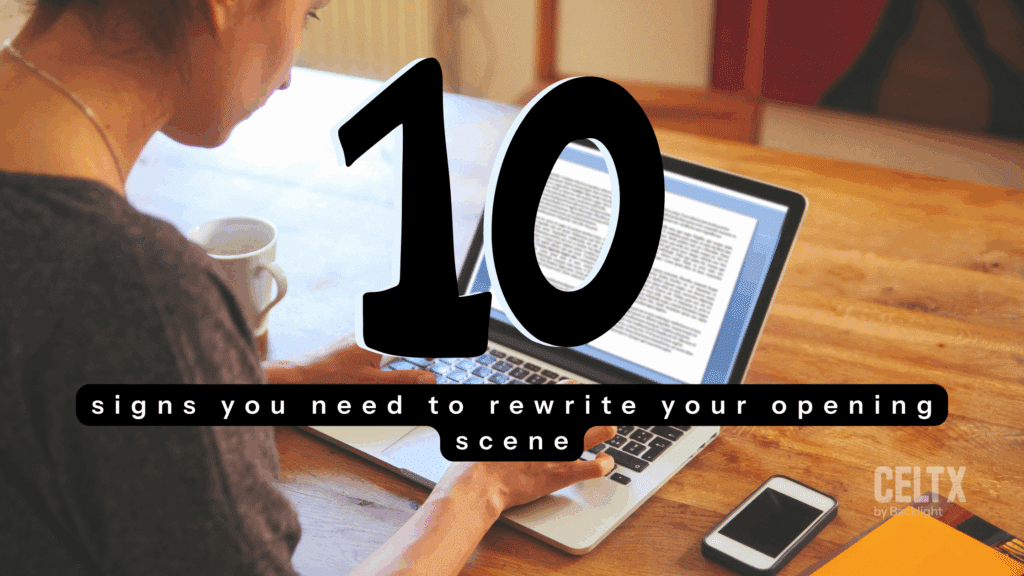
If we were to ask you what the most exciting part of a story was, we wouldn’t blame you for saying ‘the climax’! Well, yes, it’s where everything comes to a head, with the conflicts and character relationships that have been established throughout the plot so far, are put to the ultimate test.
While the climax is the most exciting part, it’s not the most important. You can’t reach the end of a story without journeying with the characters first. As screenwriters, we need to hook our audiences from the very beginning with an iconic opening scene.
And our opening scenes are very much more than just the beginning. They are a promise to our audiences that tells them what sort of story they’re in for. The first 10 pages of your script are the most important as they set the tone, introduce key elements. They either hook your audience or lose them completely. No pressure, right?
Many writers pour energy into crafting the perfect beginning. But what if your opening scene just isn’t working, and worse, what if you don’t realize it?
Well, that’s where we come in! Here are 10 signs that your opening might need a rewrite, and most importantly, how you can fix it!
In This Article:
- Signs 1-3: You’re Confusing the Audience, Not Intriguing Them
- Signs 4-6: Your Protagonist Lacks Purpose or Stakes
- Signs 7-9: The Pacing Feels Flat
- Sign 10: It Doesn’t Reflect the Tone or Genre of Your Story
- How to Rewrite with Purpose
- Killer Opening Scenes in Film and TV
- Conclusion
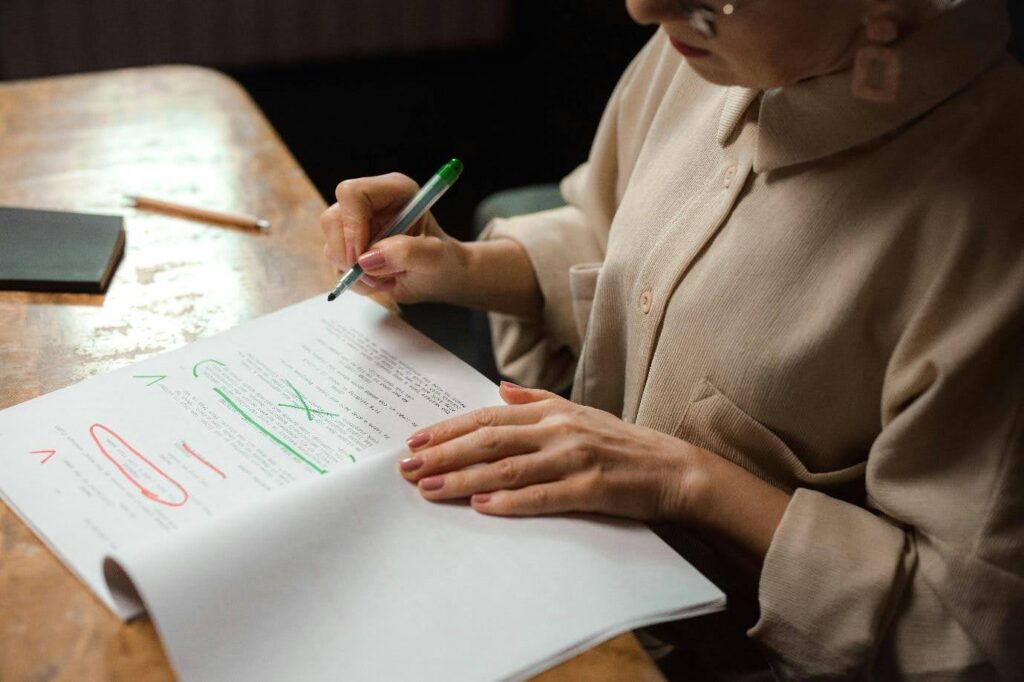
Signs 1-3 | You’re Confusing the Audience, Not Intriguing Them
1. All Questions, No Context
Mystery can be magnetic, but confusion is a dealbreaker.
For example, if your opening scene introduces strange characters, cryptic dialogue, or action without any grounding context, readers may check out before they have the chance to get curious.
How can you fix this?
Introduce just enough clarity for the audience to form a question, not scramble to understand what’s happening. Give them an emotional anchor, setting, or relatable detail.
2. Dropping Too Many Names or Terms
While it’s tempting to show off your rich worldbuilding skills right away, such as naming planets, factions, characters, histories, using excessive jargon can overload and alienate readers.
How can you fix this?
Yes, it can be super tricky but try and resist the info-dump. Instead, focus on one or two key terms and trust your world will unfold naturally. Let the audience discover your story’s richness through context and action.
3. We Don’t Know Who to Root For
It’s all well and good your movie starts with a gunfight, explosion or chase, but if we don’t know who anyone is, or why we should care, the stakes, however high, are meaningless. Flashy openings don’t matter if there’s no emotional connection.
Remember, we follow characters through stories, not just the plot.
How can you fix this?
Even in a high-octane start, give us a character to latch onto. What do they want? What’s at risk for them? A few sharp details can build empathy fast.

Sign 4–6 | Your Protagonist Lacks Purpose or Stakes
4. A Passive Main Character
An opening where your protagonist is reacting to or just observing events can feel lifeless. Active protagonists are engaging even if they don’t have full control.
How can you fix this?
Show your protagonist making a choice, even a small one. Decision reveals character and kicks off story momentum.
5. We Don’t Know What the Protagonist Wants
Desire is what drives the story. If the audience doesn’t understand what your protagonist is trying to achieve, they won’t know what to invest in.
How can you fix this?
Clarify your protagonist’s goal. It doesn’t have to be epic, but it should be clear, urgent and emotionally grounded so it’s easily identifiable by the audience.
6. The Stakes Feel Low or Abstract
If there’s nothing to lose, quite frankly, there’s nothing to care about. If the stakes aren’t high enough in a personal, physical, emotional, or relational sense, there will be no tension for the audience to engage with.
How can you fix this?
Ask yourself what happens if your character fails right now? Make the consequences visible in the scene.
Sign 7–9 | The Pacing Feels Flat
7. There’s No Clear Catalyst
There is no story without some kind of disruption that blows the status quo out of the water. If your opening meanders through description or backstory without a defining event, readers may tune out before the real story starts.
How can you fix this?
Introduce your inciting incident as early as possible. It doesn’t have to be huge, but it should shift your protagonist’s world in some way that makes them uncomfortable and send them on their way.
8. You’ve Frontloaded the Backstory
You may feel like you want to explain everything up front, from where your protagonist comes from, what led them to this moment etc, but too much exposition can really slow the momentum of your story.
How can you fix this?
Instead, cut or spread out your backstory. While you as the writer will know absolutely everything there is to know about the characters and world, only reveal what is necessary to the story. Use action and dialogue to hint at history and trust your audience to piece things together as they go.

9. The Opening Doesn’t Build
A good opening should rise in tension, reveal something new, or end with a hook that pulls the audience into the story. If your scene feels static to you, it will certainly feel like that to your audience. The scene will likely lack structure and will need to be reworked.
How can you fix this?
First, focus on your scene’s emotional arc. Does the character change, make a discovery, or face a new challenge by the end? Every scene needs motion, especially your opening.
Pacing issues? Celtx script insights break down dialogue, action,
and scene time—so you can see exactly what’s dragging.
Try Celtx for free today!
Sign 10 | It Doesn’t Reflect the Tone or Genre of Your Story
10. You’re Sending the Wrong Signal
A light-hearted romcom that opens with a violent murder? A horror story that begins with slapstick comedy? Neither of these make any sense.
If your opening scene doesn’t match the tone or genre of your story, you may attract the wrong audience or lose the right one.
How can you fix this?
Revisit your genre and emotional goal. Are you setting expectations correctly? Make sure your opening scene signals what kind of story your reader or viewer is in for.
How to Rewrite with Purpose
Before we go any further, here’s a little PSA: rewriting is part of every writing process, for everyone from new writers to the most experienced.
No first draft is perfect! Expect to revise and polish your screenplay to be the best it can possibly be.
But how do you edit and rewrite to improve your work? Recognizing the flaws in your opening is a great first step, of course, but what comes next?
Sometimes, a rewrite is more than just rewording and can involve more re-visioning. Here are our top tips to approach your rewrites with strategy and confidence.

1. Define Your Story’s Core
Before you revisit your draft, make sure you’re clear on your story’s essentials:
- Who is your protagonist?
- What do they want?
- What stands in their way?
- What’s the tone or theme you want to convey?
Your opening scene should align with these elements. If it doesn’t, you know where your rewrite needs to start.
2. Start Later, or Smarter
Many great stories begin way too early. Ask yourself, what’s the first moment that actually matters? Where does the character’s path diverge from the norm? Begin there, or even just after.
Alternatively, you may need to shift the POV, setting or sequence of events to make your opener more dynamic. The key is to stay focused on story momentum and emotional connection.
3. Test, Tweak, and Track
Rewriting can become a slippery slope without a system. Use tools like Celtx to organize your drafts, compare versions, and track changes.
This will allow you to test different structures, see what resonates, and keep a clear history of your revisions.
Are you writing your first script? We have all the advice you need in our screenwriting tools blog How to Write a Script.
Killer Opening Scenes in Film and TV
If you’re stuck for inspiration, sometimes it’s best to put down your pen or close your laptop and instead study opening scenes that absolutely nailed it!
Here are four opening scenes and screenplay extracts from film and television that show just how powerful the right beginning can be, not just as a hook but as a tone-setter and mood-establisher for what’s to come.
Let’s dive in…
Breaking Bad (2009-2013) | Pilot Episode
We open on a pair of khakis flying through the desert sky. Moments later, we see Walter White in tighty-whities and a gas mask on a desert road, recording what sounds like a goodbye message. Immediately, we are intrigued, confused, and hooked.
Breaking Bad opens with a flash forward crisis point, immediately thrusting us into high stakes and mystery. We naturally ask, “How did we get here?”
Then the episode rewinds to three weeks earlier and we begin to understand Walter’s transformation. This opening is a masterclass in juxtaposing the mundane (a chemistry teacher) with the extreme (a man preparing to die with a gun in his hand).
Here’s the opening page of the Breaking Bad pilot:
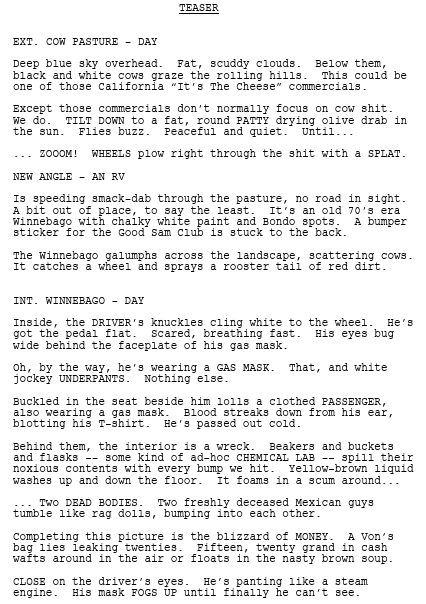
Inglourious Basterds (2009)
The movie begins with a tense, dialogue-heavy scene set in a remote French farmhouse. We’re introduced to Colonel Hans Landa, the chilling ‘Jew Hunter’. Over the first 15 minutes, we transition from polite conversation to horrifying revelation.
You can see from this scene that tension and subtext are used to grip the audience, with little dialogue. The antagonist is introduced early, so we know exactly what the threat is. The pacing is also slower, creating a huge amount of suspense, keeping us on the edge of our seats.
Take a look at how the scene was mapped out on the page:
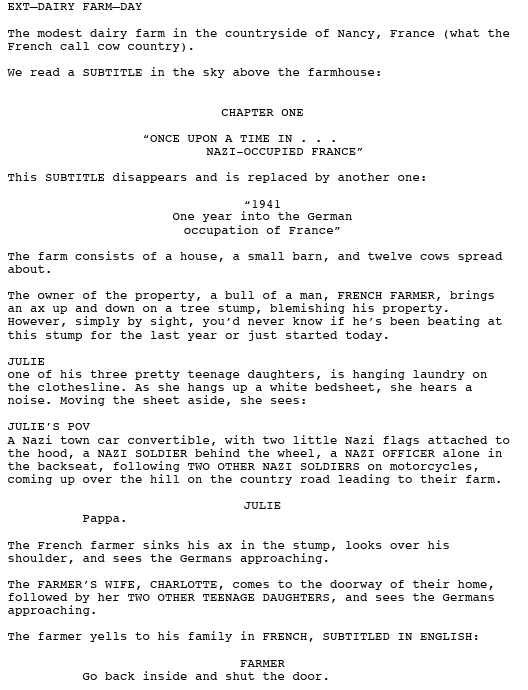
Up (2009)
Staying in 2009, we’re going to break down one of the most recognizable and tear-jerking openings in cinematic history: Carl and Ellie’s love story.
In just a few wordless minutes, Pixar delivers a montage of Carl and Ellie’s life with their dreams, disappointments, and ultimately, Ellie’s death. The story shows deep character emotion quickly through visual storytelling.
It’s both narratively brilliant and emotionally devastating. We immediately resonate with Carl as he’s left alone and are invested in the rest of his story due to what we learn in these first few scenes. Let’s see them in action in the screenplay:
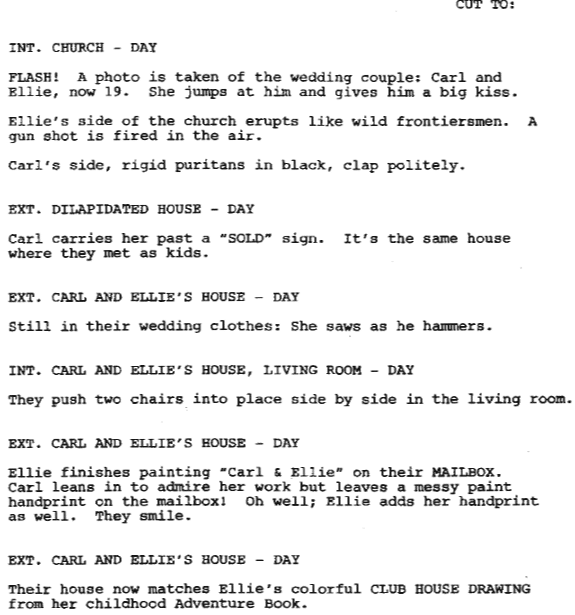

The Social Network (2010)
The rapid breakup conversation between Mark Zuckerberg and Erica Albright launches The Social Network with urgency and character insight. It’s clever, sharp and uncomfortably real to watch.
Writer Aaron Sorkin successfully uses dialogue to establish personality within a conflict situation. In turn this also sets up Mark’s flaws as a protagonist, clearly indicating what he’ll have to overcome to succeed in his goals.
By the end of this scene, we understand Mark’s insecurity, brilliance and social blindness, all themes that carry through the rest of the movie.
While it’s not a plot-heavy start, it hooks the audience with character and tension, as you’ll see in the script below:
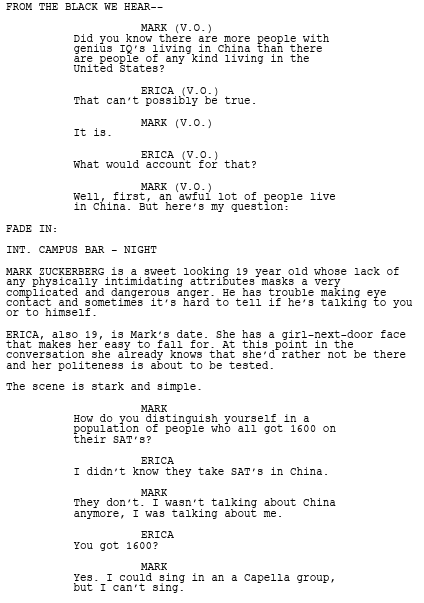
Want some more inspiration? Check out some honorable mentions here.
Conclusion
A weak opening scene doesn’t mean your story is doomed, but it is a red flag. Whether you’re getting lukewarm feedback, struggling to pitch, or just feeling off about your beginning, trust that instinct. Your audience deserves to be captivated from page one, and you have the tools to make it happen.
Rewriting your opening isn’t about getting it perfect but about making a powerful promise to your reader and then delivering on it.
Up Next:
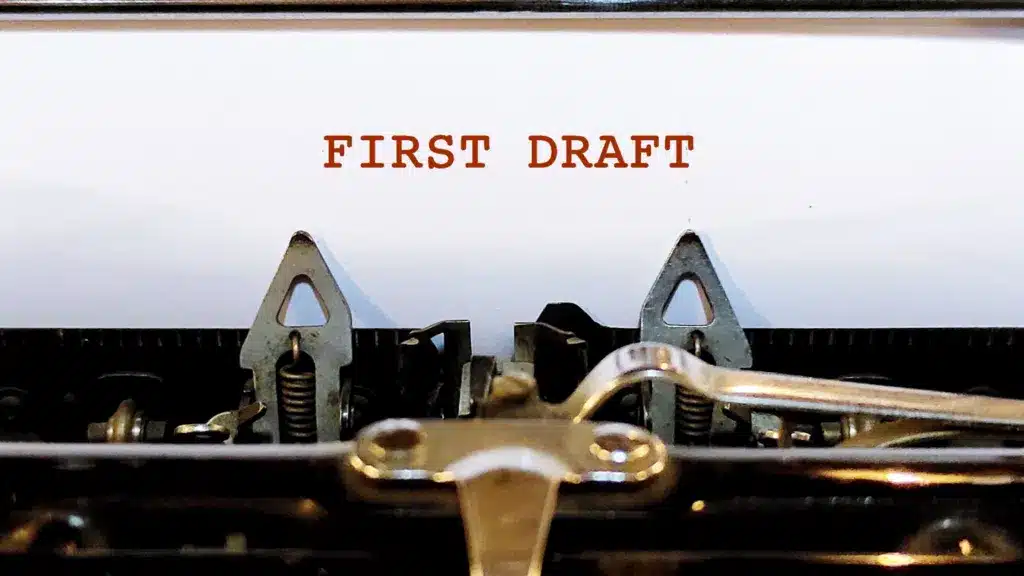
What Should the First Draft of Your Screenplay Look Like?
The first draft is the foundation of our creative process, where our ideas tumble out unfiltered, characters come to life in expected ways, and our story begins to take shape.
